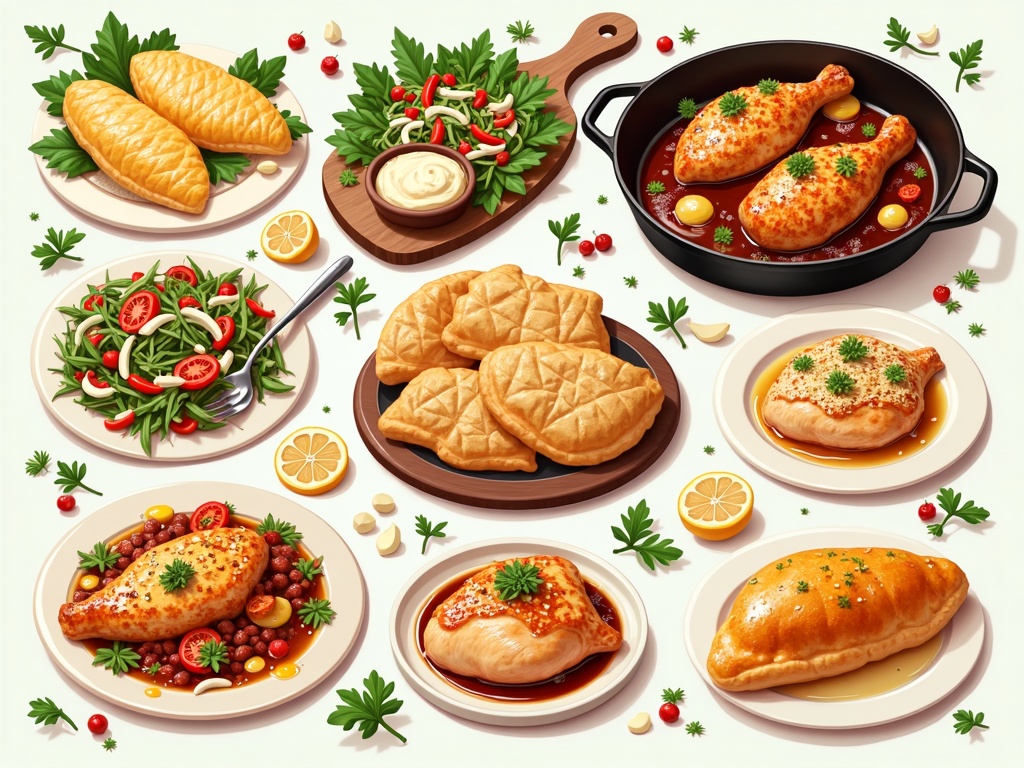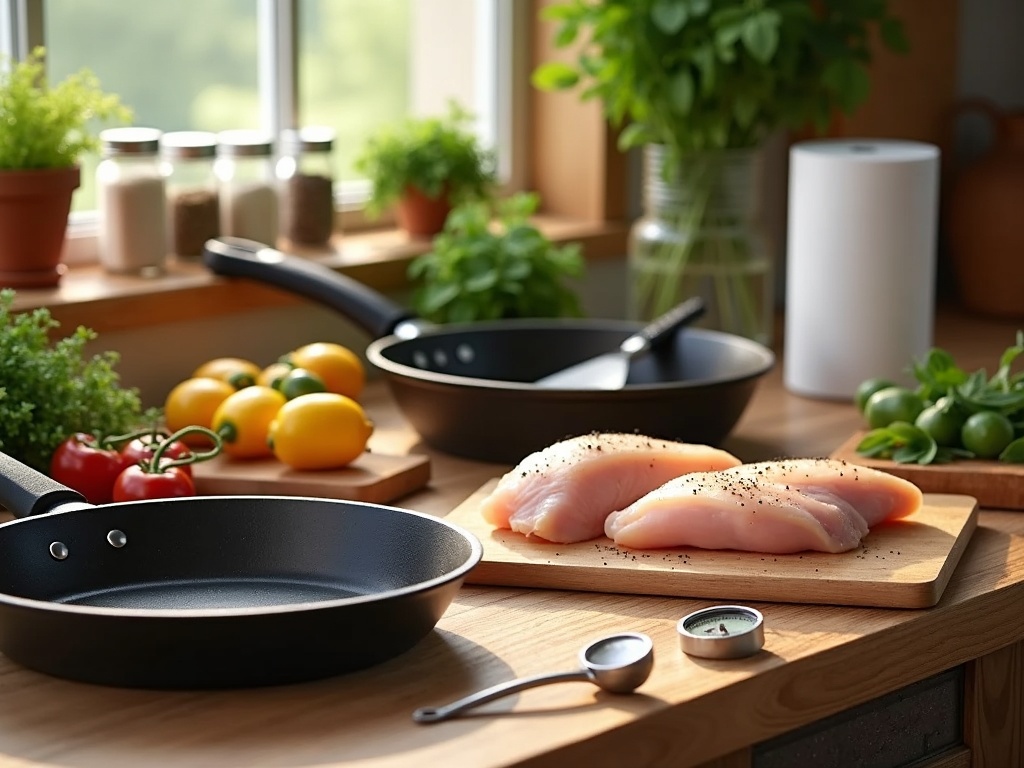Simple Chicken breast recipes serve as the perfect canvas for countless delicious meals, offering a protein-rich foundation that can be transformed with just a handful of common ingredients and simple techniques. From garlic-infused pan seers to herb-marinated bakes, chicken breast recipes combine versatility with quick cooking times, making them ideal for both weeknight dinners and special occasions.
Find In This Article
Key Takeaways
- Properly preparing chicken breast by patting it dry, seasoning generously, and bringing it to room temperature before cooking ensures juicy, flavorful results.
- Essential tools like a reliable meat thermometer, non-stick skillet, and good pair of tongs significantly improve your chicken cooking experience.
- Letting chicken rest for 5 minutes after cooking redistributes juices throughout the meat, preventing dryness when sliced.
- Cooked chicken breast can be stored in the refrigerator for up to 4 days or frozen for 3 months, making it perfect for meal prep.
- Experimenting with different flavor profiles—from Mediterranean herbs to Asian-inspired marinades—keeps chicken breast recipes exciting and versatile.
Essential Kitchen Tools You’ll Need
Preparing chicken breast recipes doesn’t require fancy equipment, but having the right tools makes cooking easier and more enjoyable. I’ve found that a few essential items can transform your chicken breast preparation from basic to brilliant.
Kitchen Essentials for Perfect Chicken
A quality non-stick skillet or cast-iron pan serves as the foundation for many chicken breast recipes. Non-stick skillets provide easy cleanup and require less oil, while cast-iron pans deliver exceptional heat retention and create that perfect sear on garlic chicken recipes. Both options work wonderfully, so choose based on what you already own or your cooking preferences.
A reliable meat thermometer is perhaps the most important tool in your chicken-cooking arsenal. Chicken breasts need to reach 165°F (74°C) internally to be safe, but cooking beyond that can quickly lead to dry meat. When I’m making boiled chicken breast, I still use my thermometer to ensure it’s cooked just right.
Paper towels are simple but essential for patting chicken breasts dry before cooking. This step is critical for achieving a beautiful golden crust on fried chicken or when preparing butter chicken. Moisture is the enemy of browning, so don’t skip this step!
A good pair of tongs gives you the control needed to flip and move chicken breasts without piercing them. This helps keep all those flavorful juices inside where they belong, particularly important when making dishes like chicken kiev where preserving the butter filling is crucial.
Finally, a sharp knife makes all the difference when preparing chicken. Whether you’re butterflying breasts for stuffed recipes, dicing for chicken pie, or simply slicing cooked chicken for serving, a sharp blade ensures clean cuts without tearing the meat.
These five tools form the backbone of my chicken cooking arsenal. With them, I can tackle virtually any chicken breast recipe with confidence, knowing I have everything needed to achieve perfect results every time.
Simple Ingredients for Perfect Chicken
I’ve found that creating delicious chicken dishes doesn’t require a pantry full of exotic ingredients. With just a handful of staples, you can transform plain chicken breasts into mouth-watering meals that’ll impress everyone at your table.
Essential Ingredients for Chicken Success
Boneless, skinless chicken breasts serve as the perfect canvas for countless recipes. They cook quickly and absorb flavors beautifully, making them ideal for weeknight dinners. When shopping, I look for plump, pinkish breasts with minimal fat streaks for the best results.
Salt and black pepper might seem basic, but they’re truly the foundation of good chicken flavor. I always season generously on both sides before cooking – this simple step makes a remarkable difference in the final taste. For even better results, try seasoning your chicken breasts about 30 minutes before cooking to allow the salt to penetrate deeply.
A good fat is essential for both flavor and cooking technique. I alternate between olive oil and butter depending on the recipe. Olive oil works wonderfully for higher-heat cooking methods like pan-searing, while butter adds rich flavor for gentler cooking or finishing sauces. For the best of both worlds, I sometimes add a pat of butter during the final minutes of cooking garlic chicken to create a luscious finish.
While chicken can shine with just salt and pepper, adding a few extra seasonings can elevate your dish with minimal effort. These optional but impactful additions include:
- Garlic powder: Adds savory depth without the prep work of fresh garlic
- Paprika: Brings beautiful color and subtle sweetness
- Italian herbs: Creates Mediterranean flair perfect for chicken kiev recipes and other European-inspired dishes
I’ve discovered that combining these simple ingredients in different ways creates endless possibilities. Whether I’m making a quick butter chicken on a busy weeknight or preparing a special chicken pie for Sunday dinner, these fundamental ingredients never let me down.
The beauty of working with these basic components is that they complement nearly any cooking method – from a simple fried chicken recipe to elegant poached preparations. This versatility means you can create completely different meals throughout the week using the same core ingredients.
How to Make Restaurant-Quality Chicken
Creating delicious chicken dishes at home doesn’t require professional training. With a few simple techniques, I can transform ordinary chicken breasts into restaurant-worthy meals that will impress family and friends.
Perfect Preparation
First, I always pat chicken breasts dry with paper towels. This step is crucial as moisture prevents proper browning and can cause steaming instead of searing. Once dry, I season the chicken generously on both sides. Salt and pepper are essential, but I might add garlic powder, paprika, or herbs depending on the flavor profile I’m aiming for.
Next, I heat a pan over medium-high heat. This temperature is ideal for creating that beautiful golden crust without burning the exterior. When the pan is hot, I add a tablespoon of oil or butter. Olive oil works great for Mediterranean flavors, while butter adds richness to garlic chicken recipes or simple pan-seared options.
Cooking to Perfection
I place the chicken in the hot pan carefully, laying it away from me to avoid oil splatter. The satisfying sizzle tells me the pan is at the right temperature. I cook the chicken for 5-7 minutes per side, depending on thickness. For thicker pieces, I might reduce the heat slightly after the initial sear to ensure the center cooks through without burning the exterior.
The most important part of cooking chicken breast is checking the internal temperature. I use a meat thermometer to verify it reaches 165°F—the safe temperature for poultry. This step eliminates guesswork and ensures juicy results every time.
Once cooked, I let the chicken rest for 5 minutes before slicing. This redistributes the juices throughout the meat rather than having them run out when cut immediately. The result is moist, flavorful chicken that rivals any butter chicken recipe or fried chicken from restaurants.
This method works wonderfully whether I’m making a simple weeknight dinner or preparing chicken for chicken pie or chicken kiev. The versatility of properly cooked chicken breast makes it a staple in my kitchen for countless recipes.
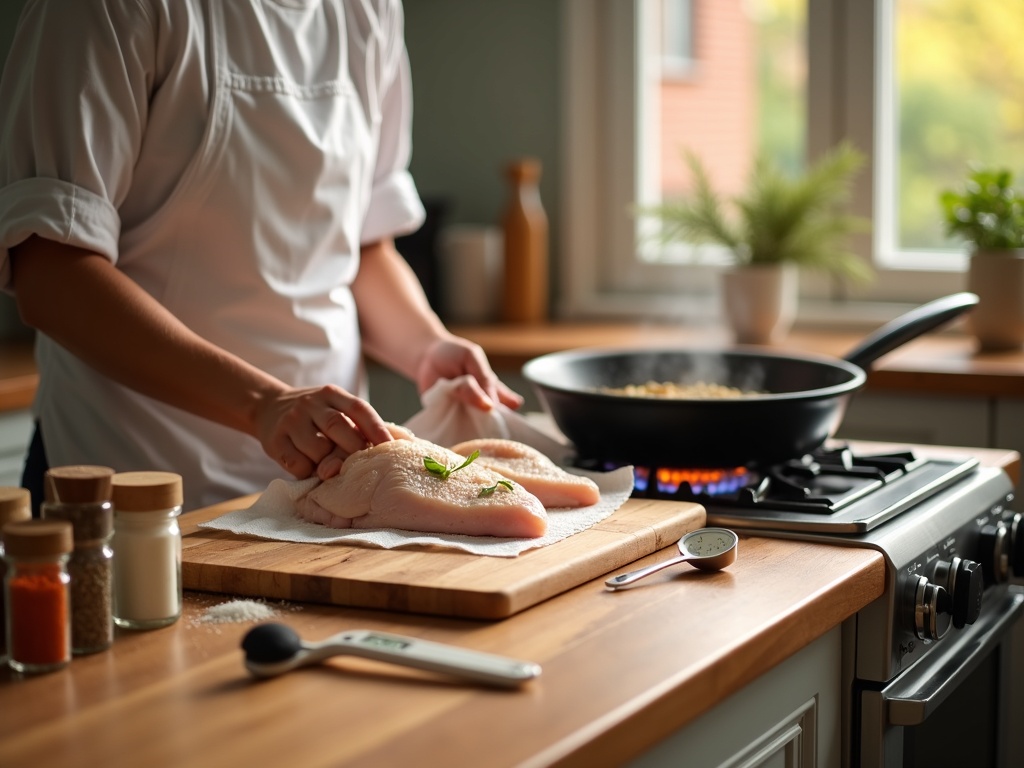
Common Mistakes to Avoid
I’ve seen home cooks make several critical errors when preparing chicken breasts. These mistakes often result in dry, tough, or unevenly cooked meat that fails to live up to its potential. By recognizing and avoiding these common pitfalls, you’ll significantly improve your chicken dishes.
Key Errors That Ruin Chicken Breast
Skipping the drying step is a frequent mistake that undermines your cooking before you’ve even begun. When chicken breasts are wet, they steam rather than sear. Before cooking, I always pat chicken breasts completely dry with paper towels. This simple step creates that beautiful golden crust we all crave on perfectly crispy fried chicken and helps seasonings adhere better to the meat.
Cooking cold chicken straight from the refrigerator leads to uneven cooking. The outside may burn while the inside remains raw. Let your chicken sit at room temperature for about 15-20 minutes before cooking. This small time investment ensures the heat distributes more evenly through the chicken breast during cooking.
Moving chicken too much while it cooks prevents proper browning. I know it’s tempting to peek, flip, and prod, but resist the urge! Place your chicken in a hot pan and leave it undisturbed until it naturally releases from the cooking surface. This patience results in that gorgeous caramelization that adds incredible flavor to dishes like garlic chicken.
Cutting into chicken immediately after cooking causes all those flavorful juices to escape onto your cutting board instead of redistributing throughout the meat. Always let chicken rest for at least 5 minutes before slicing. This waiting period makes a remarkable difference in juiciness, especially in recipes like butter chicken where moisture retention is crucial.
Overcrowding the pan creates another common problem. When chicken pieces touch or overlap, they release moisture that gets trapped, causing them to steam rather than sear. This leads to pale, rubbery chicken instead of the beautifully browned pieces you want for a chicken pie recipe. I always cook in batches if needed to give each piece enough space.
Additional mistakes to watch for include:
- Under-seasoning or only seasoning one side of the chicken
- Relying solely on breast meat temperature without considering carryover cooking
- Using the wrong pan temperature (too high scorches the outside; too low prevents browning)
- Neglecting to pound thick chicken breasts for even cooking
- Using dull knives when cutting raw chicken, which tears rather than cleanly cuts the meat
These errors can transform what should be a tender, juicy chicken kiev into a disappointing meal. The good news? Each mistake has a simple fix that doesn’t require fancy equipment or professional training.
By avoiding these common errors, you’ll elevate your chicken breast dishes from merely acceptable to truly excellent. Pay attention to these details, and you’ll notice a dramatic improvement in flavor, texture, and overall satisfaction with your chicken recipes.
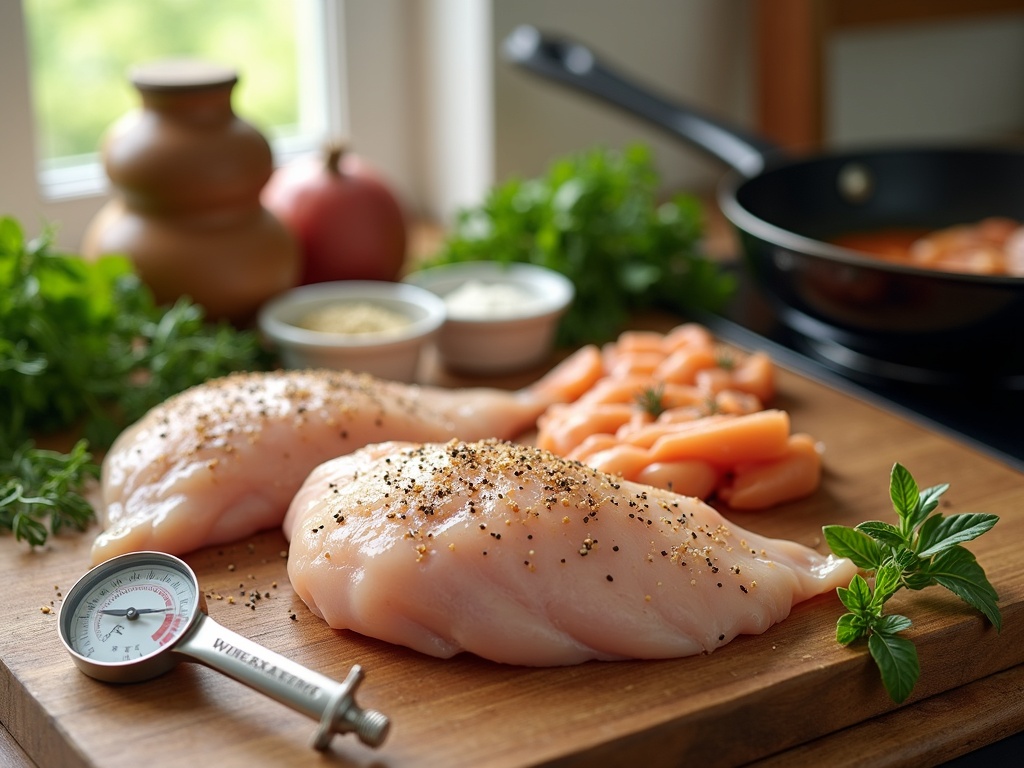
Pro Tips for Tender Results
Getting perfectly tender and juicy chicken breast doesn’t need to be complicated. With a few simple techniques, I can transform an ordinary piece of chicken into something extraordinary. These tips have helped me avoid the dreaded dry, tough chicken that nobody wants to eat.
Essential Preparation Techniques
I always make sure to take my chicken out of the refrigerator about 20-30 minutes before cooking. Cold chicken straight from the fridge will cook unevenly, often resulting in overcooked outer edges by the time the center reaches the right temperature. Room temperature chicken cooks more uniformly.
For pieces with uneven thickness, I pound them gently. This simple step makes all the difference in achieving evenly cooked garlic chicken or any chicken dish. I place the chicken between two sheets of plastic wrap and use a meat mallet or rolling pin to create an even thickness throughout.
Seasoning is crucial, but timing matters too. I season my chicken just before it hits the pan. Salt draws out moisture, so if you season too far in advance without marinating, you might end up with drier chicken. A simple mix of salt, pepper, and your favorite herbs applied right before cooking works wonders.
Medium-high heat is my go-to setting for perfect searing. This creates that beautiful golden crust that seals in juices while cooking the chicken through without burning. For fried chicken recipes, maintaining the right temperature is especially important.
After cooking butter chicken or any chicken dish, don’t waste those flavorful pan drippings! I create a quick sauce by adding a splash of broth or white grape juice, a pat of butter, and herbs to the hot pan. Scraping up the browned bits creates an instant sauce that elevates the simplest chicken breast.
These techniques have helped me prepare everything from basic grilled chicken to more complex dishes like chicken Kiev or chicken pie. The principles remain the same regardless of the specific recipe – treat the chicken with care before and during cooking, and you’ll be rewarded with tender, juicy results every time.
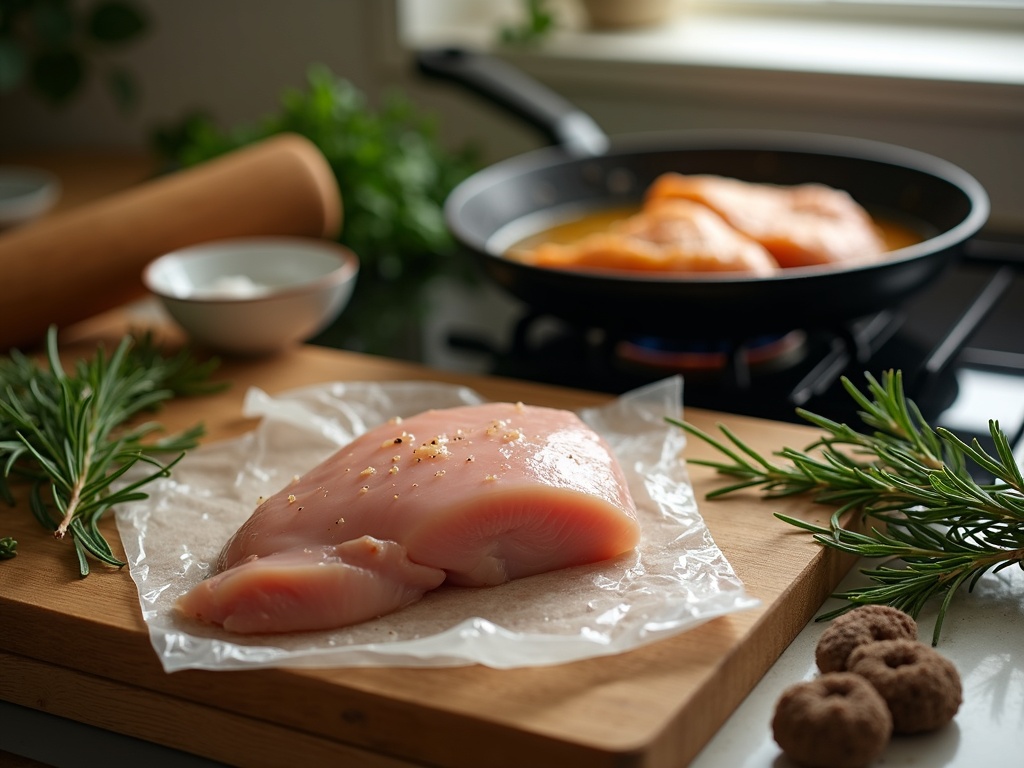
Storage and Meal Prep Ideas
Preparing chicken breasts in advance can save me valuable time during busy weekdays. I’ve found that proper storage techniques make all the difference in maintaining the flavor and texture of cooked chicken breasts.
Effective Storage Methods
Cooked chicken breasts should always be stored in an airtight container to prevent bacterial growth and preserve freshness. When placed in the refrigerator, properly stored chicken breasts remain safe to eat for up to 4 days. For longer storage, freezing is the best option – frozen cooked chicken can maintain quality for up to 3 months. I like to slice or shred the chicken before freezing, which makes it easier to thaw only the amount needed for a particular meal.
When meal prepping, I prepare several garlic chicken breasts at once and store them for various uses throughout the week. Sliced chicken works wonderfully in salads, providing a protein boost without additional cooking time. It’s also perfect for quick sandwiches – just add some greens and a spread for an instant lunch.
For meal prep, these ideas can transform your stored chicken into exciting meals:
- Add to grain bowls with roasted vegetables for a balanced lunch
- Mix into pasta dishes for a protein-rich dinner
- Combine with a butter chicken sauce for a quick version of a classic favorite
- Stuff into wraps with fresh vegetables for an on-the-go meal
- Dice and add to soups for extra substance
When reheating stored chicken breast, gentle methods work best to prevent the meat from drying out. I add a splash of chicken broth or water before microwaving, or reheat in a covered pan on low heat. For fried chicken recipes, reheating in an air fryer or oven helps maintain the crispy exterior.
The best part about properly stored chicken breast is its versatility. One batch of boiled chicken breasts can transform into multiple meals throughout the week, from chicken pie to a simple sandwich. This approach saves both time and money while ensuring I always have protein ready for quick, healthy meals.
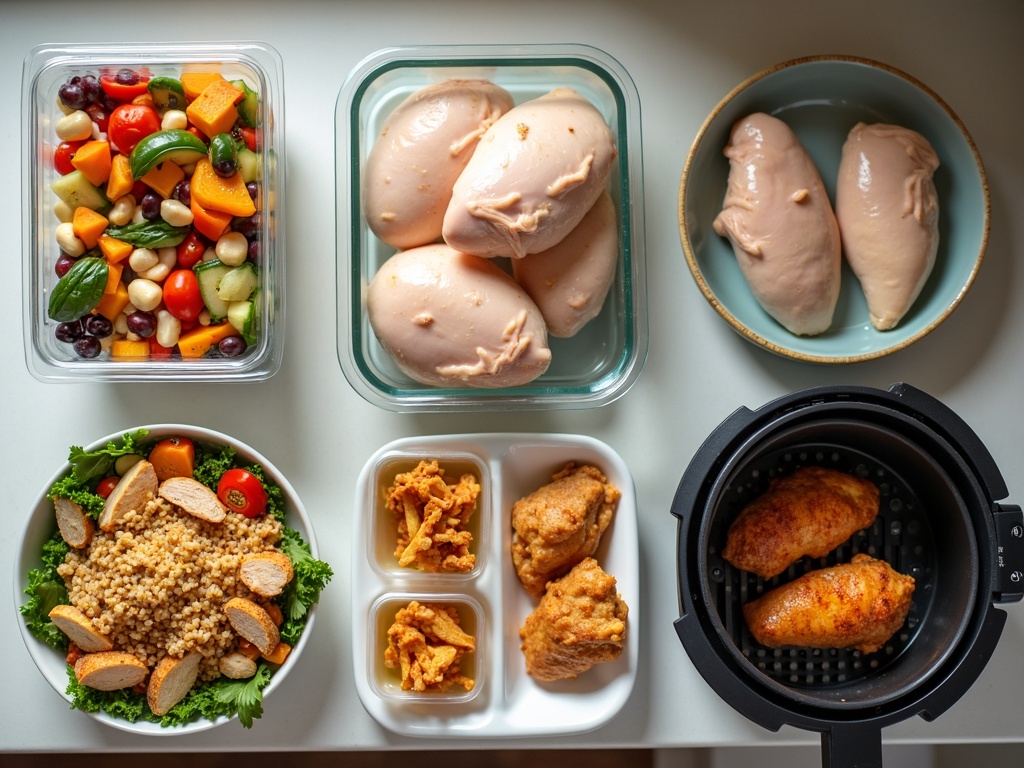
Flavor Variations to Try
Adding different seasonings to chicken breast transforms this versatile protein into exciting meals. I’ve experimented with numerous flavor profiles and discovered these standout variations that require minimal effort but deliver maximum taste.
Global Inspirations
Lemon herb chicken brings brightness to any meal. I combine fresh lemon juice, minced garlic, and herbs like thyme, rosemary, and parsley. For best results, marinate the chicken for at least 30 minutes before cooking. This refreshing combination works perfectly with properly boiled chicken breast that’s finished with a quick sear.
Cajun seasoning adds a spicy kick that transforms plain chicken into something special. I mix paprika, cayenne, garlic powder, onion powder, oregano, and thyme to create an authentic blend. This seasoning works best when rubbed onto the chicken before cooking it in a cast-iron skillet. The result pairs wonderfully with rice or in a hearty sandwich.
Mediterranean-style chicken features olive oil, lemon juice, garlic, oregano, and a touch of cumin. This combination creates a juicy, flavorful garlic chicken that’s perfect alongside a Greek salad or wrapped in a pita with tzatziki sauce.
Asian and Classic Favorites
Asian-inspired marinades elevate chicken breast with bold flavors. I often combine soy sauce, ginger, garlic, honey, and a splash of rice vinegar. This mixture works magic when allowed to marinate for a few hours. The sweet-savory balance creates a delicious glaze when the chicken is cooked, similar to what you’d find in a butter chicken recipe but with different flavor notes.
Simple garlic butter sauce might be the easiest yet most impressive way to enhance chicken breast. I melt butter with minced garlic, add a squeeze of lemon juice, and finish with chopped parsley. This rich sauce can be drizzled over pan-seared or fried chicken for an instant upgrade.
For a weekend project with more complex flavors, try adapting techniques from a chicken Kiev recipe by creating a pocket in the chicken breast and filling it with compound butter before cooking.
These variations keep chicken breast interesting in your meal rotation. Each offers a different taste experience while maintaining the health benefits of this lean protein. Mix and match these flavors or use them as inspiration for your own signature chicken recipes.
